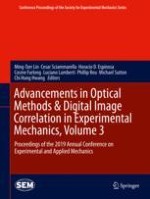2020 | Buch
Advancements in Optical Methods & Digital Image Correlation in Experimental Mechanics, Volume 3
Proceedings of the 2019 Annual Conference on Experimental and Applied Mechanics
herausgegeben von: Prof. Ming-Tzer Lin, Prof. Dr. Cesar Sciammarella, Prof. Horacio D. Espinosa, Prof. Cosme Furlong, Prof. Luciano Lamberti, Dr. Phillip Reu, Michael Sutton, Chi-Hung Hwang
Verlag: Springer International Publishing
Buchreihe : Conference Proceedings of the Society for Experimental Mechanics Series
